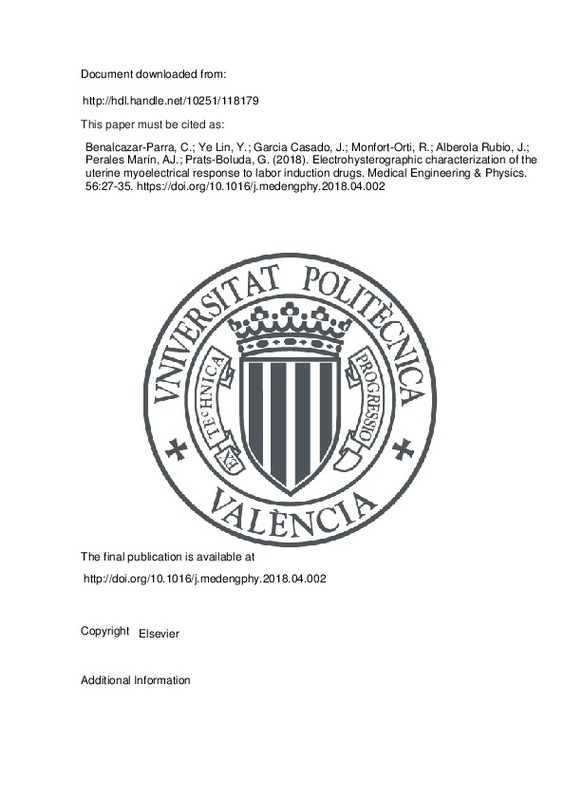JavaScript is disabled for your browser. Some features of this site may not work without it.
Buscar en RiuNet
Listar
Mi cuenta
Estadísticas
Ayuda RiuNet
Admin. UPV
Electrohysterographic characterization of the uterine myoelectrical response to labor induction drugs
Mostrar el registro sencillo del ítem
Ficheros en el ítem
| dc.contributor.author | Benalcazar-Parra, Carlos
|
es_ES |
| dc.contributor.author | Ye Lin, Yiyao
|
es_ES |
| dc.contributor.author | Garcia Casado, Javier
|
es_ES |
| dc.contributor.author | Monfort-Orti, Rogelio
|
es_ES |
| dc.contributor.author | Alberola Rubio, José
|
es_ES |
| dc.contributor.author | Perales Marín, Alfredo Jose
|
es_ES |
| dc.contributor.author | Prats-Boluda, Gema
|
es_ES |
| dc.date.accessioned | 2019-03-15T21:02:08Z | |
| dc.date.available | 2019-03-15T21:02:08Z | |
| dc.date.issued | 2018 | es_ES |
| dc.identifier.issn | 1350-4533 | es_ES |
| dc.identifier.uri | http://hdl.handle.net/10251/118179 | |
| dc.description.abstract | [EN] Labor induction is a common practice to promote uterine contractions and labor onset. Uterine electrohysterogram (EHG) has proved its suitability for characterizing the uterus electrophysiological condition in women with spontaneous labor. The aim of this study was to characterize and compare uterine myoelectrical activity during the first 4h in response to labor induction drugs, Misoprostol (G1) and Dinoprostone (G2), by analyzing the differences between women who achieved active phase of labor and those who did not (successful and failed inductions). A set of temporal, spectral and complexity parameters were computed from the EHG-bursts. As for successful inductions, statistical significant and sustained increases with respect to basal period were obtained for EHG amplitude, mean frequency, uterine activity index (UAI) and Teager, after 60¿ for the G1 group; duration, amplitude, number of contractions and UAI for the G2 group, after 120¿. Moreover, Teager showed statistical significant and sustained differences between successful and failed inductions (1.43±1.45 µV2.Hz2.105 vs. 0.40±0.26 µV2.Hz2.105 after 240¿) for the G1 group, but not in the G2 group, probably due to the slower pharmacokinetics of this drug. These results revealed that EHG could be useful for successful induction prediction in the early stages of induction, especially when using Misoprostol. | es_ES |
| dc.description.sponsorship | This research project was supported by the Spanish Ministry of Economy and Competitiveness and the European Regional Development Fund (DPI2015-68397-R) and by the company Bial SA. | |
| dc.language | Inglés | es_ES |
| dc.publisher | Elsevier | es_ES |
| dc.relation.ispartof | Medical Engineering & Physics | es_ES |
| dc.rights | Reconocimiento - No comercial - Sin obra derivada (by-nc-nd) | es_ES |
| dc.subject | Labor induction | es_ES |
| dc.subject | Cervical ripening | es_ES |
| dc.subject | Drug effects | es_ES |
| dc.subject | Surface electromyography | es_ES |
| dc.subject | Electrohysterography | es_ES |
| dc.subject | Signal processing | es_ES |
| dc.subject | Computer-assisted signal interpretation | es_ES |
| dc.subject.classification | TECNOLOGIA ELECTRONICA | es_ES |
| dc.title | Electrohysterographic characterization of the uterine myoelectrical response to labor induction drugs | es_ES |
| dc.type | Artículo | es_ES |
| dc.identifier.doi | 10.1016/j.medengphy.2018.04.002 | es_ES |
| dc.relation.projectID | info:eu-repo/grantAgreement/MINECO//DPI2015-68397-R/ES/ELECTROHISTEROGRAFIA, CONSTRUYENDO PUENTES PARA SU USO CLINICO EN OBSTETRICIA/ | es_ES |
| dc.rights.accessRights | Abierto | es_ES |
| dc.date.embargoEndDate | 2019-06-01 | es_ES |
| dc.contributor.affiliation | Universitat Politècnica de València. Departamento de Ingeniería Electrónica - Departament d'Enginyeria Electrònica | es_ES |
| dc.contributor.affiliation | Universitat Politècnica de València. Instituto Interuniversitario de Investigación en Bioingeniería y Tecnología Orientada al Ser Humano - Institut Interuniversitari d'Investigació en Bioenginyeria i Tecnologia Orientada a l'Ésser Humà | es_ES |
| dc.contributor.affiliation | Universitat Politècnica de València. Servicio de Alumnado - Servei d'Alumnat | es_ES |
| dc.description.bibliographicCitation | Benalcazar-Parra, C.; Ye Lin, Y.; Garcia Casado, J.; Monfort-Orti, R.; Alberola Rubio, J.; Perales Marín, AJ.; Prats-Boluda, G. (2018). Electrohysterographic characterization of the uterine myoelectrical response to labor induction drugs. Medical Engineering & Physics. 56:27-35. https://doi.org/10.1016/j.medengphy.2018.04.002 | es_ES |
| dc.description.accrualMethod | S | es_ES |
| dc.relation.publisherversion | http://doi.org/10.1016/j.medengphy.2018.04.002 | es_ES |
| dc.description.upvformatpinicio | 27 | es_ES |
| dc.description.upvformatpfin | 35 | es_ES |
| dc.type.version | info:eu-repo/semantics/publishedVersion | es_ES |
| dc.description.volume | 56 | es_ES |
| dc.identifier.pmid | 29699891 | |
| dc.relation.pasarela | S\357295 | es_ES |
| dc.contributor.funder | Ministerio de Economía, Industria y Competitividad | es_ES |







![[Cerrado]](/themes/UPV/images/candado.png)

